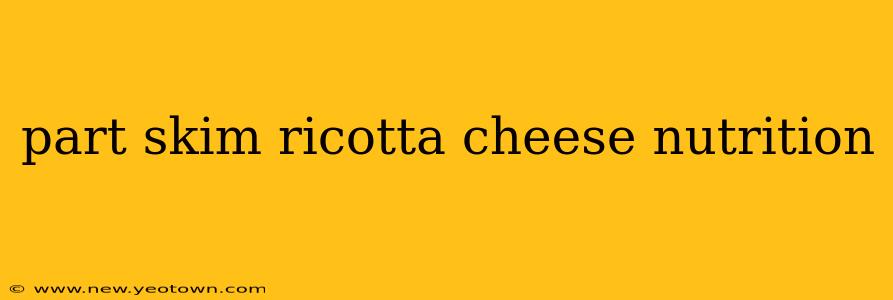Ricotta cheese, with its creamy texture and subtly sweet flavor, is a staple in many cuisines. But what about part-skim ricotta? Is it a healthier choice than whole milk ricotta? Let's delve into the nutritional profile of part-skim ricotta cheese and explore its place in a balanced diet. This isn't just a quick rundown; we'll examine its composition, benefits, and potential drawbacks, answering many common questions along the way.
What is Part-Skim Ricotta Cheese?
Imagine a creamy, dreamy cheese made not from the milk itself, but from the leftover whey – the liquid remaining after cheesemaking. That's ricotta! Part-skim ricotta takes this process a step further. Instead of using whole milk whey, it utilizes whey from milk that has had some of its fat removed. This results in a cheese that's lower in fat and calories than its full-fat counterpart, while still retaining that characteristically smooth and soft texture.
How Does Part-Skim Ricotta Compare to Whole Milk Ricotta?
The key difference lies in the fat content. Whole milk ricotta boasts a richer, creamier texture due to its higher fat percentage. Part-skim ricotta, on the other hand, has a slightly lighter texture and a lower calorie count. This makes it a popular choice for those watching their weight or aiming to reduce their saturated fat intake. Let's put this in perspective with a typical nutritional comparison (values may vary slightly depending on the brand):
| Nutrient | Whole Milk Ricotta (1 cup) | Part-Skim Ricotta (1 cup) |
|---|---|---|
| Calories | ~300 | ~200 |
| Fat (g) | ~20 | ~8 |
| Saturated Fat (g) | ~12 | ~5 |
| Protein (g) | ~28 | ~25 |
| Calcium (mg) | ~500 | ~450 |
Is Part-Skim Ricotta Healthy?
The health benefits of part-skim ricotta largely stem from its lower fat content compared to whole milk ricotta. It's a good source of protein, essential for building and repairing tissues, and a decent source of calcium, crucial for bone health. However, moderation is key, as it still contains some saturated fat and sodium.
How Much Part-Skim Ricotta Should I Eat?
There's no magic number, as dietary needs vary widely based on individual factors like age, activity level, and overall health goals. However, using part-skim ricotta as part of a balanced diet, rather than a significant portion of your daily intake, is a smart approach. Consider it a component of a meal, not the main event.
What are the Benefits of Eating Part-Skim Ricotta?
- Lower in Fat and Calories: This is the primary advantage, making it a better choice for weight management.
- Good Source of Protein: Essential for muscle building and repair.
- Calcium Rich: Supports bone health.
- Versatile in Cooking: Can be used in sweet and savory dishes.
What are the Drawbacks of Eating Part-Skim Ricotta?
- Slightly Lower in Certain Nutrients: Part-skim ricotta naturally has slightly less fat-soluble vitamins than whole milk ricotta.
- Sodium Content: Be mindful of the sodium content, especially if you are watching your salt intake.
- May Not Have the Same Rich Taste: Some find the texture and taste slightly less rich compared to full-fat ricotta.
Can Part-Skim Ricotta Help with Weight Loss?
Part-skim ricotta can contribute to weight loss as part of a balanced diet and exercise plan. Its lower calorie and fat content compared to whole milk ricotta makes it a more weight-conscious choice. However, it's not a magic bullet; overall dietary habits and physical activity play crucial roles in weight management.
Conclusion: A Deliciously Balanced Choice
Part-skim ricotta cheese offers a delicious compromise between taste and health. Its lower fat content makes it a potentially beneficial option for those watching their weight or wanting to lower their saturated fat intake. Remember to incorporate it into a balanced diet and enjoy it as part of a healthy lifestyle. Don't just take our word for it – give it a try and see how it fits into your culinary adventures!

